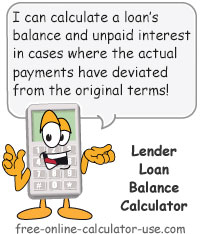IMPORTANT: Numeric entry fields must not contain dollar signs, percent signs, commas, spaces, etc. (only digits 0-9 and decimal points are allowed).
Click the Terms tab above for a more detailed description of each entry.
Step #1:
If you will be printing the loan amortization schedule or you will be tracking more than one loan (Cloud subscription), enter the name of the loan.
Step #2:
Enter the original principal amount borrowed at the beginning of the payment schedule.
Step #3:
Enter the annual percentage rate of the loan.
Step #4:
Enter the original loan term in the number of monthly payments.
Step #5:
Enter the original monthly payment amount. Note that if you leave the payment field blank, the calculator will calculate the monthly payment amount for you when you create the payment schedule.
Step #6:
Select the month and enter the 4-digit year of the date to start the payment schedule.
Step #7:
Select the month and enter the 4-digit year of the date to end the payment schedule.
Step #8:
Select either the "US Rule" or "Normal" amortization method.
Step #9:
Press the "CreateCreate SchCreate Editable ScheduleCreate Editable Payment Schedule" button to create the editable payment schedule.
Step #10:
Use the Next and Previous buttons, or the period select menu, to view and change any payment amounts that were different from the prescribed payment amount. Use the adjustment column to add late fees (entered as negative numbers) or to add extra principal payments.
Step #11:
Once you have made all of the payment revisions, press the "Show Schedule" button. This will display a scrollable revised amortization schedule, followed by a "Printer Friendly Schedule" button for printing the schedule, and a "Download CSV File" button for downloading and importing the revised schedule into Excel or Open Office Calc.


Follow me on any of the social media sites below and be among the first to get a sneak peek at the newest and coolest calculators that are being added or updated each month.